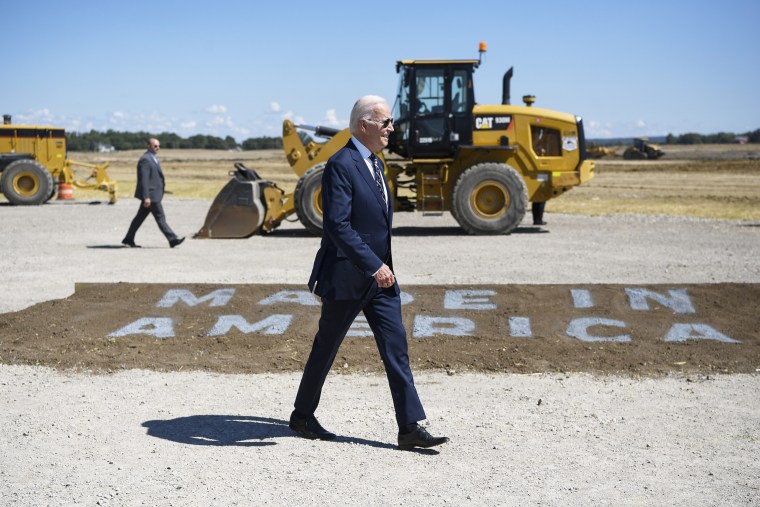WASHINGTON — The global race to build next-generation computer chips has come to Nebraska, and dozens of other states as well.
In the coming months, the government plans to begin doling out more than $50 billion for semiconductor research and manufacturing as part of the CHIPS and Science Act it became law last year. The prospect of so much cash has sparked a scramble between states to present themselves as the best place to spark a semiconductor boom.
The CHIPS legislation was designed to help beef up America’s supply chain when it comes to the production of computer chips used in everything from coffee pots and cars to pacemakers and missiles. While the move was primarily focused on addressing national security and economic concerns about a lack of domestic manufacturing, it presents an unexpected opportunity for state and local governments.
More than a dozen states have begun putting together incentive packages with tax credits, zoning changes and cuts in regulatory red tape to attract the limited number of companies looking to expand their US chip production. The states are struggling , according to data from the Semiconductor Industry Association and interviews with industry leaders and officials.
“We haven’t had this kind of economic potential since corn,” said Nebraska State Senator Mike McDonnell, who has introduced legislation to pave the way for chipmakers looking to expand in his state. «It’s a great idea and it’s something that can really help change the state of Nebraska.»
National security experts and corporate executives have urged the US for years to do more to bolster its domestic chip manufacturing, with Taiwan making 92% of the world’s most advanced chips.
But the pitfalls were on full display during the pandemic when Covid lockdowns and supply chain disruptions caused a global shortage of chips, leading to shortages of appliances, cars and manufacturing equipment. Adding to the urgency are heightened tensions between the US and China and concerns that China may be moving towards annexing Taiwan, which could jeopardize US chip supplies.
In anticipation of federal funds, semiconductor companies have already made billions of dollars in commitments. Since the bill was introduced in spring 2020, companies have announced plans for $187 billion in new or expanded semiconductor facilities in 16 states that would create more than 30,000 jobs. according to the Semiconductor Industry Association.

“I don’t think it’s an exaggeration to say it’s historic and unprecedented,” Dan Berglund, director of the State Institute of Science and Technology, said of the inflow of federal and state funds to expand manufacturing.. “Between the CHIPS Act and some of the other bills that Congress passed last session, you really have an opportunity to completely restructure or reshape American manufacturing.”
Racing for the next big deal, state officials are proposing to cut taxes and ease regulations while touting everything from their power grid to reliable weather in an effort to lure chipmakers.
In Michigan, officials hope to use its auto industry and highly-skilled manufacturing workforce to their advantage. The state has also tried to promote its climate to its advantage, as despite the cold winters, the state is mostly insulated from extreme weather events such as hurricanes, floods, or wildfires. The state has already seen a boom in chip-reliant EV and battery-making facilities, spurred in part by separate legislation last year that offered incentives for EV production.
“This is like nothing I’ve ever seen before,” said Quentin Messer, director of the Michigan Economic Development Corporation. “Once upon a time, if you had a billion-dollar opportunity, you thought, ‘Wow, I may never see that again.’ We now have a portfolio of more than 20 projects that cost at least a billion dollars.”
In Kansas, officials are «ready and loaded» with a series of proposals for federal dollars as soon as the application process opens, according to Paul Hughes, assistant secretary for business development at the Kansas Department of Commerce.
He said state officials have been talking with companies and the Biden administration for months to hone his pitch, which will focus on the final stage of chip production in the aerospace and defense-related industries.
But competition for the dollars will be fierce, as several states have spent years laying the groundwork for becoming a semiconductor hub.
Before moving to Kansas, Hughes worked on efforts in Arizona to convince the world’s largest chipmaker, Taiwan Semiconductor Manufacturing Company, to open a $40 billion facility there, something the company announced last year. But he said those kinds of opportunities are rare and expectations for some states may be out of control.
«It gets competitive quickly, so it will be interesting to see how some of these states do,» Hughes said. «You definitely won’t get it if you don’t try, but there are quite a few of them who are probably a little too enthusiastic, or maybe their expectations aren’t quite in line with reality.»

New York state officials spent more than a year in ongoing talks with semiconductor company Micron before being selected last October as the site for a $20 billion semiconductor campus. near Syracuse. Officials there hope the project, which could grow to as much as $100 billion, will transform the face of the region, returning it to its former glory of cutting-edge manufacturing.
New York’s argument for Micron touted everything from the large number of engineers graduating from schools within a two-hour radius of Syracuse to the region’s power grid, as Micron would have access to power from four different regions of the state, including carbon-free. power from hydroelectric and nuclear power plants.
«There’s a feeling here that Syracuse missed out on a piece of the technology wave of the second industrial revolution. We missed it, a lot of communities missed out on parts as well, and the goal here obviously is to figure out how to reconnect with that,» Dominic Robinson said. , Senior Vice President of the CenterState Corporation for Economic Opportunity of New York, which represents the state’s business community.
Along with competition among themselves, states also have to compete in a global marketplace. Europe is working on its own semiconductor program to the tune of 43 billion euros, and China is reportedly considering whether to offer more than $100 billion worth of subsidies to sustain its semiconductor industry.
But expanding a US semiconductor industry in a matter of years instead of decades is fraught with challenges, industry leaders said..
The country lacks the workforce of highly specialized engineers and manufacturing workers to operate the facilities, and paying those workers will make it more expensive to build and operate a plant in the US than in Asia, even with government subsidies. and tax exemptions. At the same time, technology companies have seen a slowdown in demand over the past year, prompting them to lay off workers and look for ways to cut costs, said Thomas Sonderman, chief executive of California-based semiconductor company SkyWater Technology. Minnesota.
“There will be a ‘made in America’ premium that people will have to be comfortable with, and in the end it’s about economics,” Sonderman said. “The bill was passed when we were in this big boom in the semiconductor industry. The industry is going through a correction now around the same time that CHIPS will be rolled out, and in many ways, for certain companies, their sense of urgency may have been lessened.”
SkyWater Technology chose Indiana for its new $1.8 billion facility due to access to workforce training programs at Purdue University and the ease of doing business in the state, Sonderman said.
Indiana is among states that have been aggressively courting chipmakers, with Gov. Eric Holcomb and state economic development leaders traveling to Taiwan last August to introduce the state to makers of computer chips and vehicle batteries. electrical.
While the Midwest isn’t known as a semiconductor hotspot and doesn’t have an established workforce, Sonderman says he sees those states have an advantage because of their apparent hunger to catch the next manufacturing boom.
“Those who think differently, are hungry or anxious or agile and can move quickly, I think they will be the ones that will take advantage of CHIPS in a unique way,” he said. «That’s why when you look at the map of where semiconductors are made in the US today, and then you project five years, it’s going to be a very different map.»
